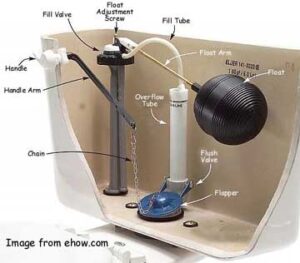How to Fix a Running Toilet
The sound of a running toilet…it can keep you awake at night. If your toilet is running constantly, you could be wasting 200 gallons of water or more every day. (US EPA Water Sense) Not only is that running wasteful, it can also be expensive.
Most repairs are simple and inexpensive and don’t require a plumber so there’s really no reason to ignore that leak. We’re going to offer some ideas to get you started.

Get to Know Your Tank
To get started you’ll need to remove the lid from the top of the toilet tank and set it aside. You might want to place it on a towel to catch any water that might be on it and to prevent it from breaking.
Take a look at the diagram to familiarize yourself with the various parts inside the tank. Don’t be afraid to get your hands wet. The water in the tank is clean (unlike the water in the bowl)! Any discoloration in your tank would be the result of mineral accumulation.
The tank is what houses the equipment that controls the water in the tank and bowl. The tank is the equivalent of a bucket of water, holding the water until needed.
Flushing the toilet lifts the flush valve and allows the water to flow into the toilet bowl. The flow activates the siphon that sucks the water and any waste into the sewer system. The flapper then covers the hole, and the fill valve injects water into the bowl and fills until the float reaches a certain level and shuts off the valve.
Disclaimer
The following information is informational and educational in nature. We encourage you to contact a plumber if you are not confident in your ability to attempt these simple repairs. We assume no liability for any damages that might occur from your repairs.
Troubleshoot the Problem
When the toilet runs, it means the water is flowing into the tank or bowl and not stopping. Either the toilet runs and never stops, or it stops for a while and then starts again without the help of a flush.
Steady Running
Jiggle the handle on your toilet. Does the running water sound stop? If so, you need to adjust the chain or the handle itself. Here’s how:
- Check the mounting nut for the handle on inside of the tank. It may be sticking and not letting the handle get back in the right place when it’s let go. If that is the case, simply clean it.
- Check the chain to make sure it doesn’t have too much slack. If this happens, it can get caught under the flapper, causing water to leak down into the toilet.
- Check to be sure the chain isn’t broken. Often these get corroded or just weakened over time and break apart. Replace this with a new one so it hangs straight with about a 1/2″ in slack.
- If you don’t have a chain in your tank, check to be sure your lift-wire isn’t bent. If it is, try straightening it out until the toilet operates smoothly.
If the toilet is still running when the tank lid is lifted, then the problem should be apparent. The most common problem is the flapper hasn’t covered the hole all the way and the water is continuously draining into the toilet. The float never reaches proper height and water continuously enters the tank and the bowl.
First, simply reposition the flapper over the hole and flush again. Watch to see if the flapper covers the hole or it if becomes askew again. If it is askew, then the flapper’s rubber has become deformed or worn, and it’s not positioning itself correctly or the chain connected to the valve is damaged or caught.
A caught or kinked chain just needs to be readjusted, but deformed flappers or damaged chains need to be replaced. These are easily found at most hardware and department stores.
Intermittent Running
Sometimes the toilet will run, stop and later run again. Opening the tank shows nothing out of the ordinary. The flapper covers the hole and the float is working perfectly. In this case a leaky flapper is slowly letting water flow into the tank. The water fills up after a flush and a small hole leaks the water into the bowl. It isn’t fast enough to keep the float from shutting off the fill valve, but once it shuts off the water will slowly drain causing the fill valve to restart.
Over time, the rubber on the flapper becomes worn and creates these small leaks. The only remedy is a new flapper.
Toilet Still Running or Need Extra Help?
There are many helpful how-to videos on the Internet. Below are just a few:
- https://www.diynetwork.com/how-to/skills-and-know-how/plumbing/how-to-fix-a-leaking-toilet (DIY network)
- https://www.youtube.com/watch?v=z5324QzZB38 (Home Depot)
- http://www.youtube.com/watch?v=muSBRudVJKg (Howcast)
If you’re still not sure or are unable to fix the leak yourself, it might be time to call a plumber!
Preventive Maintenance
It’s a good idea to test annually for silent leaks using dye tablets or food coloring. Simply drop a dye tablet or a few drops of food coloring in your tank and wait a few minutes. If color appears in your toilet bowl, you know you have a leak.
